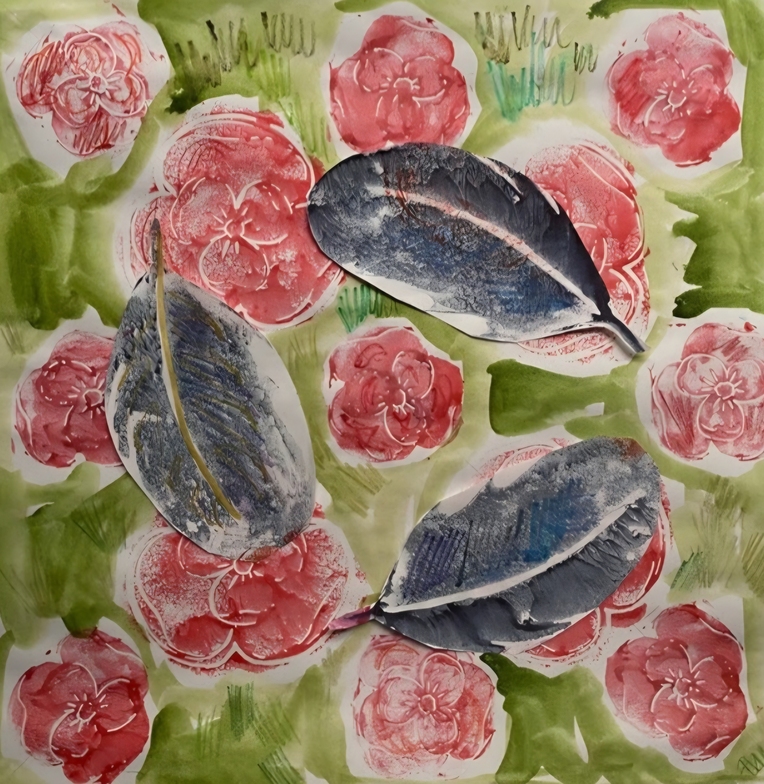
Image credit: Elizabeth Mathers, untitled. From the Remembrance themed art contest coordinated by Jenn Ashton, Indigenous Cultural Sensitivity Leader at St Clement's
I think I’ve spoken before about my grandmother Dorothy, who was a member of the Auxiliary Territorial Service (ATS) in Britain during the Second World War. Though she was only seventeen at the time, Dorothy put her age up so she could join her sister—whom she desperately admired—in the war effort. "The rise of Adolf Hitler in the 1930s, and the threat of another global war, led to the formation of the ATS, a new women’s unit to free up male soldiers for the front line."
I remember my grandmother telling me how the ATS was all the buzz. The camps were where all of the socializing—the dances happened for her peer group. It was where she and her friends went to meet boys (they were lined up round the block in granny’s day, she would tell me), and the camaraderie between the members was something my grandmother often spoke of.
It was also a time of tremendous social change for women throughout what was then known as the British Empire. Roles in the ATS were “initially limited to cooks, clerks, orderlies, storekeepers and drivers. However, the jobs available were gradually broadened as demand for personnel increased.”
Regimental Sergeant Major Mary Coomer famously said, “We did the same duties as the men. When they stood on guard all night they had their rifle, when we stood on guard we had a broom handle.”
About 300 women from the West Indies also served in Britain's Auxiliary Territorial Service. “At first, these women were rejected by the War Office on grounds of colour, and later with claims that they would struggle to adapt to the British climate and culture, which would affect their ability to work effectively. However, the growing demand for personnel, along with the Colonial Office’s request for a non-discriminatory recruitment policy on the grounds that it would greatly improve relations between Britain and the Caribbean, meant that black women were allowed to enlist in the ATS from 1943.”
I remember my grandmother’s service every year at this time, together with all of the brave women of the ATS. This year, though, there is something that’s sticking out to me from her wartime stories that I hadn’t thought about before, and that’s just how ordinary of a thing it was, at least according to my grandmother, for people to sign up to go to war in those days.
My grandmother didn’t mean to glorify war by remembering her service with such fondness, nor did she ever intend to romanticise the very real cost of going to war. But by talking about just how ordinary of a thing it was to enlist, she helped me remember how full of everyday hopes and dreams are the people who find themselves in places of conflict.
I remember when I learned that the young people behind many of the resistance movements around the world today, were, before their homes were occupied, enrolled in totally mainstream university degree programs like architecture or nursing. It’s something I try to hang on to when news reports of death tolls in warzones risk becoming mere numbers. Each number is a person, whose dreams may be as simple as getting to hang out with their cool, older sibling, getting an education—meeting a boy at a dance.
In the light of this, I've always struggled to know where Christian faith fits in with war. What is the role of faith in wartime? You will no doubt have your own answers to that question, and I look forward to hearing them. I learned recently that it was in 1914, during the First World War, that Pope Benedict XV used the feast of All Saints to issue his encyclical Ad beatissimi Apostolorum, “a call for European nations to end the [First World] [W]ar and establish peace.” Over the last year, letters from clergy and lay people across the Church have poured into MP offices across the country, urging the Canadian government to call for a permanent ceasefire in Gaza. We have a long history in the Christian faith of calling for an end to war.
Our faith also calls us as the living to commemorate the dead. Remembrance Sunday has long been a part of the Anglican Church of Canada’s calendar, and thanks to the efforts of Jenn Ashton, Indigenous Cultural Sensitivity Leader at St Clement’s, Indigenous Veterans Day is for the first time this year also marked on our calendars.
I was seeing on Facebook last week a custom our sibling churches in the Northern Philippines have of visiting the graves of their relatives and ancestors during All Souls and All Saints and decorating gravestones with candles and wreaths and flowers, and praying for the dead. It’s actually from this All Saints and All Souls tradition of visiting memorials that we get many of our civil Remembrance Day customs of standing by monuments that specifically remember casualties of war.
Our faith is a demanding one: calling for an end to war, remembering the casualties of war, these require a great deal of patience, perseverance, and hope. The promise I’m leaning on this year is the one Martha once confessed, when Jesus said to her, ‘I am the resurrection and the life. Those who believe in me, even though they die, will live, and everyone who lives and believes in me will never die. Do you believe this?’
“Yes, Lord, I believe,” Martha said.
Yes, Lord, I believe. Amen.
